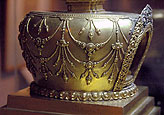Under Geghen Zanabazar (1635-1723) was a descendant of Chingis Khan, born into a prominent Oirot Mongol family. In the late 17th century, following a period of civil strife between the Oirots and the Khalkas, he supported the idea of Qing (Manchu) sovereignty over Mongolia. Considered to be a living reincarnation of one of the important earlier Buddhist leaders in Mongolia, became the first Jebsundamba Khutuktu (Bogdo Khan) or theocratic ruler of Mongolia under Qing auspices. He is much revered for his contributions to Buddhist learning and for his reforms of Mongolian Buddhism. As a sculptor, he has been called the “Mongolian Michelangelo.” His most exquisite work can be seen in some of the gilded bronze statues in the Fine Arts Museum and in the winter palace museum of the last Bogdo Khan in Ulaanbaatar.



|
Vairocana Buddha
Mash giiguulen zikhioghch, 17th c.
Pub.: Zanabazar, no. 45a-f, pp. 82-87; cf. Rhie and Thurman, p. 347
|


|
Otoch Manal/Bhaisajyaguru/The Medicine Buddha
19th c., school of Zanabazar.
Pub.: Zanabazar, no. 51a-b, pp. 107-108
|



|
Manjuśri
Zoolon Egshigt, 18th c.
Pub.: Zanabazar, no. 50a-b, pp. 105-106
|



|
Akśobhya Buddha
G. Zanabazar (?), 17th c.
Cf. Rhie and Thurman, p. 345
|

|
Palm impressions of Zanazabar
|



|
Amithaba Buddha
17th c.
|



|
Sita Tara/White Tara
Tsagaan Dar Ekh, 17th c. Gilded bronze.
Pub.: Zanabazar, no. 48a-c, pp. 98-100; cf. Rhie and Thurman, pp. 124-125, 134
|




|
Bodhi Stupa
G. Zanabazar, 17th c. Gilded bronze
Pub.: Zanabazar, no. 48a-e, pp. 78-81
|



|
Amoghasiddhi, the Tathagata of the north
Cf. Rhie and Thurman, p. 349
|
























